No One Makes It Through Underwater Demolition Team Training, They Said. They Were Wrong.
I grew up in Richland, Washington, and enrolled at Washington State University in the fall of 1959. By my junior year, I really wasn’t too happy there and didn’t think I was going to finish. Meanwhile, guys I knew were getting drafted left and right. You could get college deferments, but I didn’t think I would qualify because my grades were not very good. So I quit school and spent a few months in the U.S. Forest Service in northern Idaho over the summer. And then in the fall, I joined the Navy—mostly because I didn’t want to get drafted into the Army.
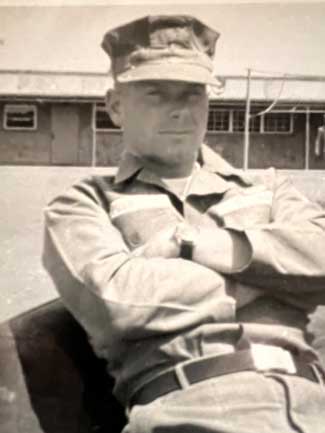
Ned Pugh joined the Navy in 1962—mostly because he didn’t want to be drafted into the Army. Photo courtesy of the author.
I went to boot camp in San Diego in November 1962, and after I graduated I met with the yeoman (which is what they called the Navy secretary back then). He told me I had really good test scores, and that he could get me any school I wanted—submarine, electronics, or radioman. But I was mostly interested in underwater demolition. I didn’t know much about it, but I loved Lloyd Bridges in Sea Hunt and wanted to be a frogman.
The old yeoman told me I was an idiot, that nobody makes it through underwater demolition team training, and that I’d lose the option to apply to other Navy schools. But I held my ground. So he signed off on my papers and threw them across the desk.
“Get out of here, you dumb shit!” he said.
The Underwater Demolition Teams originated in the Pacific theater of World War II. Their main objective was to identify and remove obstacles such as mines and barbed wire to create safe passage for landing craft and amphibious forces. They also conducted reconnaissance missions to gather intelligence on enemy coastal defenses as well as assessed the conditions of potential landing sites, including depth of water and determining the nature of the seabed. This information was crucial for planning successful amphibious assaults.
I started Underwater Demolition Teams school in April of 1963. I was part of class number 30, which started with 130 guys. The first two weeks were mostly a lot of running and physical training, not unlike what I had gone through in boot camp. Hell Week was the third week. We were all nervous, wondering who was going to make it through and who wasn’t.
At midnight on Sunday, the instructors come in banging big soup spoons on garbage cans. “Everybody up, put on your clothes!”
They immediately marched us out of the barracks and right into San Diego Bay. Guys started dropping out pretty quickly from there, many in the first 24 hours. Most had quit by Wednesday or, at the latest, Thursday.
One guy in our class, named Bob, was built like a Greek god, and all the women at Coronado Beach loved him. A few days earlier, we had all voted him most likely to make it through. But by Wednesday everyone was like, “Where’s Bob?”
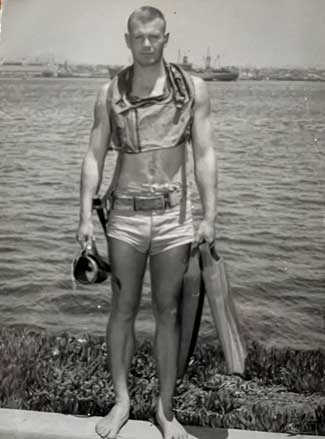
Ned Pugh forged ahead with Underwater Demolition Team school even after he was told there was no future in it. Photo courtesy of the author.
No one knew where he was—he had disappeared. Someone ran into him a few weeks later and asked him what happened. He said he couldn’t stand the cold.
I took it day by day. At the end of each day, I’d say to myself, “That was a pretty shitty day, but I’ll give it one more day and see how it turns out.” And that’s how I got through it.
After Hell Week we were down to 40 guys. Training continued. Two weeks from graduation, we began submarine operations training, which took place on an old World War II-era diesel sub that had been recommissioned a few years earlier. The exercise was designed to teach us to exit the sub using the escape trunks, which were used for both covert operations and emergencies.
There was only room for three people at one time: one instructor and two trainees, called tadpoles. This was a “no bottles exercise,” meaning no tanks. The other trainee was Jim Crane. Our instructor was Boatswain Mate 1st Class Lawrence Cifuentes.
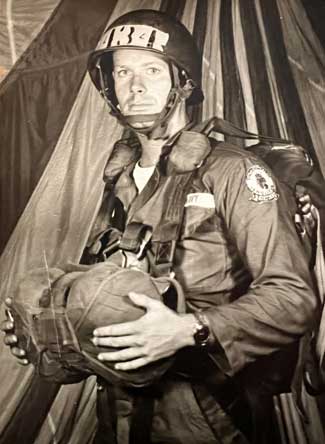
Ned Pugh at jump school in Fort Benning, Georgia, in 1963. Photo courtesy of the author.
They closed the door and began to flood the lock. We had to rely on the bubble of air at the top to breathe. Everything went according to plan as the water rose to the required level. But when the door equalized to the outside pressure, we saw that it was stuck. Later I would be told that a nylon line jammed on the door’s sill. Everything started going sideways at that point.
The instructor, distracted by the line, forgot to ask that the inside pressurized water be stopped. The water, under 75 pounds of pressure, came steadily in, greatly reducing our life-sustaining air bubble. The instructor opened an overhead valve in an attempt to get more air into the lock, but that didn’t work. The water continued to rise, and soon we were reduced to sucking air from the ceiling of the lock.
Award-Winning Journalism in Your Inbox
With 300 pounds of air in the lock, our eardrums ruptured. Blood splattered the sidewall of the lock. The instructor frantically reached down between his knees, trying to find and open the sea valve to let the water out. At that pressure, it would have drained the lock in seconds. But no such luck.
I thought that was the end.
Lucky for us, the diving officer noticed the gauges and jumped into action. They stopped the incoming water and reversed the flow, meanwhile venting the chamber gingerly to keep the lock from blowing apart. At the same time, the alarms in the interior of the sub came alive and the emergency klaxon sounded to surface the sub.
Suddenly the water level dropped below our ears. The sub surfaced in seconds, and when the door at the top of the lock was jerked open, we were bloody but alive.
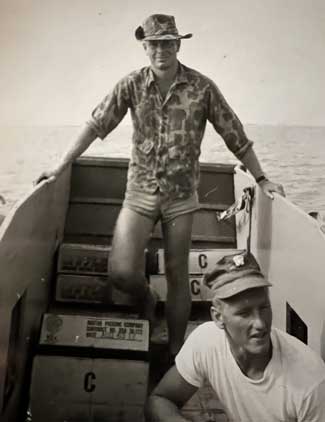
Ned Pugh with Lt. Overstreet in Vietnam 1965. Photo courtesy of the author.
I was sent to the naval hospital in San Diego Balboa. After treatment, I got called in to speak with the head officer of training. He told me I was going to have to stay out of the water for a while. At first, I thought they were going to roll me back to the next class, but the officer told me all my run times and swim times and class work were up to snuff, that they knew I was going to make it through anyway, so I would stay with Class 30.
I found out later that the class had voted on whether I should be rolled back or kept, and they decided to keep me.
I graduated in August 1963. By then we were down to just 30 out of the original 130. We spent the next year in Coronado, California, training and drinking beer. President Kennedy was assassinated in November of that year. I met my beautiful future wife, Carla Jean, during that time, and we got married in August 1964.
I deployed to Vietnam with Underwater Demolition Team 12 in November 1964. The United States wasn’t officially at war, but when we first landed at Da Nang Air Base I saw U.S. Army body bags piled up on the tarmac.
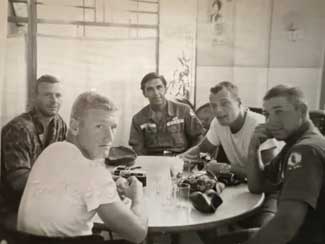
Ned Pugh, left, in southern Thailand, with Lt. Overstreet, John Campbell, Lt. Larson, and Errol Johnson. Photo courtesy of the author.
We were headquartered in the Philippines and from there were sent on various missions. When the Marines landed in Da Nang on March 8, 1965, they assigned our team to the beach to make sure none of them fell down into the water and drowned. We were basically lifeguards. It was kind of a circus, with beautiful girls with flowers out on the beach, and a bunch of media taking photographs—hardly a forced landing!
The only real action I saw was a few months later when they sent us to recon a beach at the north end of Da Nang Harbor. We got in our line, with a swimmer positioned every 20 or 30 feet, making our chart as we moved down the beach. That’s when a sniper in the jungle started shooting at us. Fortunately, he was a bad shot, but I had a couple of bullets go over my head.
That is a very distinct sound.
Other missions were more peaceful, and not all were in Vietnam. At one point we were sent to map out the coastline of southern Thailand. It was incredibly beautiful—just sandy beaches and fishing villages.
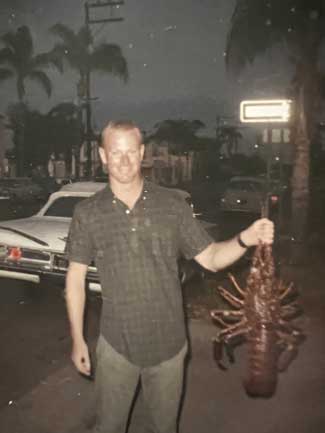
Ned Pugh in Coronado Beach with the group’s weekly dinner. The lobster fed four people. Photo courtesy of the author.
It was around this time that the Navy formed the Navy SEALs. The idea was to build on the Underwater Demolition Team’s elite swimming and diving capabilities, but add land combat skills, including jump training and counterinsurgency operations. After I returned from Vietnam I was asked if I wanted to join Navy SEAL Team 1, and I enthusiastically said yes. But then I learned that I would be asked to extend my service another 18 months, which would mean another deployment to Vietnam. My son Jeff had been born in March of that year, and I had since learned that old Navy yeoman was right. There wasn’t much chance for advancement in the Navy from there. I decided to get out.
I heard from Lawrence Cifuentes about 15 years ago. The submarine operations training incident haunted him his whole life. He blamed himself, and he was relieved that I didn’t still hold it against him all these years later.
Our Journalism Depends on Your Support
My ears never really bothered me too much, though I do wear hearing aids now. I have 30% disability, including 10% for hearing loss and 10% for tinnitus. I got off easy compared to many of my friends and fellow veterans.
Two years later my younger brother Brad joined Underwater Demolition Team 12 and was critically injured when he set off a tripwire while clearing a Viet Cong bunker north of Da Nang.
But that’s a whole other story.
This story was written by Ned Pugh with the support of his son-in-law, Robert Einaudi, coauthor of “Radioman.” An excerpt from that book, It’s Every Young Marine’s Dream. But I Don’t Like This Story, was published in The War Horse in April 2023. You can connect with Robert on LinkedIn or visit his website roberteinaudi.com.





Comments are closed.